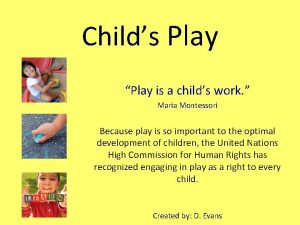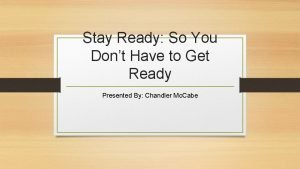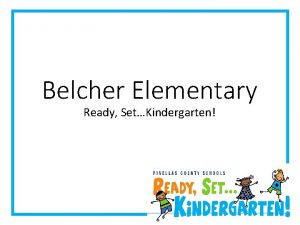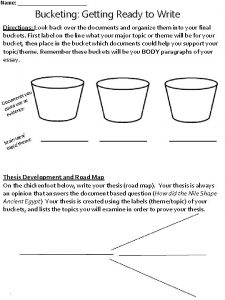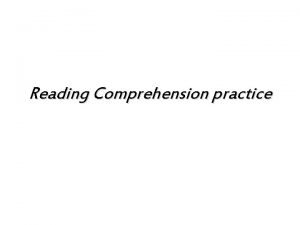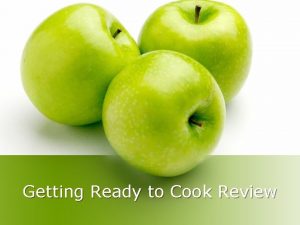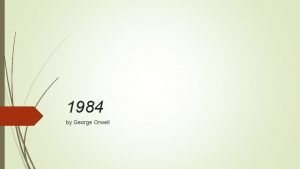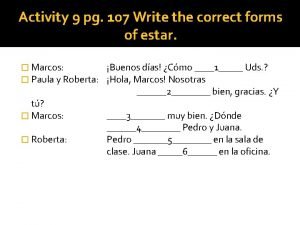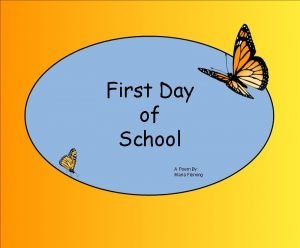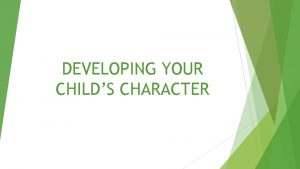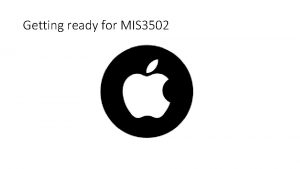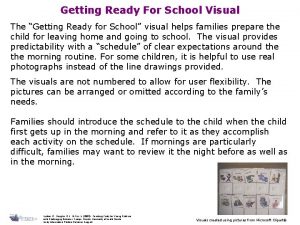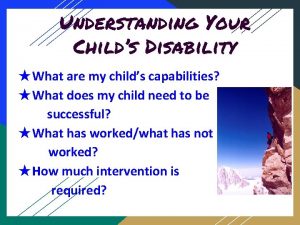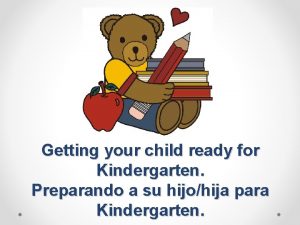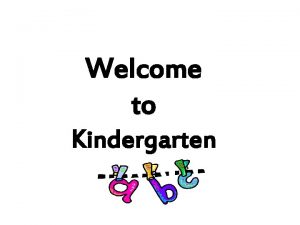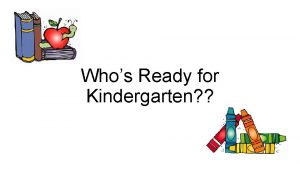Getting Ready for Kindergarten Mathematics Your Childs First











- Slides: 11

Getting Ready for Kindergarten Mathematics!

Your Child’s First Teacher • Is you! • Research suggests parent participation is directly related to your child’s success. • Pre-kindergartners and kindergartners love mathematics making it easy to support at home. • The following slides are ideas and suggestions to help your child “get ready” for Kindergarten Mathematics!

Understanding Numbers • • Count everything! Count toys, dinner plates, snacks, and socks in the dryer. Help your child count by pointing to and moving the objects as you say each number out loud. Count forwards and backwards from different starting places. Sing counting songs and read counting books. Sing songs such as, "One, Two, Buckle My Shoe" and "Ten Little Monkeys". Read counting books such as Anno’s Counting Book by Mitsumasa Anno. Explore how numbers are used inside and outside your home. Hunt for numbers in your home, neighborhood, books, magazines or the newspaper. Point numbers out on the clock, television, cellphones, stove, microwave, etc. Ask your child to help you solve everyday number problems. "We need four tomatoes to make salad for dinner, and we have only two. How many more do we need to buy? " "Two guests are coming for dinner. How many forks will we need? "

Understanding Measurements • • Measure items found around the house. Have your child find objects that are longer or shorter than a ruler. Use items such as popsicle sticks or string to measure the length of objects such as a doormat. Fill different containers with sand or water and see which containers hold more or less. Estimate everything! Estimate the number of steps from your front door to the car, then walk with your child to find out how many there really are. Estimate how many rolls of paper towels your family will need for the week. At the end of the week, count up the number of paper towels you actually used. Compare and organize household items. Take boxes or cans from the pantry and have your child line them up from tallest to shortest. Talk about time. Ask your child to check the time on the clock when he goes to school, eats meals, and goes to bed. Together, look up the time of a television program your child wants to watch.

Understanding Geometry • • Identify shapes and sizes. When playing with your child, identify things by their shape and size: "Pass me an ice cube. " "Take the largest potato chip bag out of the pantry. " Hide a toy and use directional language to help your child find it. Give clues using words and phrases such as up, down, over, under, between, through, and on top of. Play "I spy", looking for different shapes. "I spy something that is round. " "I spy something that is rectangular. " "I spy something that looks like a cone. " Go on a "shape hunt". Have your child look for as many circles, squares, triangles, and rectangles as he or she can find at home or outside. Hunt for three-dimensional objects like cubes, cones, spheres, and cylinders also.

Understanding Patterns • • Look for patterns in storybooks and songs. Many children's books and songs repeat lines or passages in predictable ways, allowing children to recognize and predict the patterns. Create patterns using your body. Clap and stomp your foot in a particular sequence (clap, stomp), have your child repeat the same sequence. Teach your child simple dances that include repeated steps and movements. Hunt for patterns around your house and neighborhood. Your child will find patterns in clothing, on toys, and among trees and flowers in the park. Encourage your child to describe the patterns found. Try to identify the features of the pattern that are repeated. Use household items to create and extend patterns. Lay down a row of spoons pointing in different directions in a particular pattern (up, down, up, down) and ask your child to extend the pattern.

Understanding and Managing • Sort household items. As your child puts away their toys or Data clothing, discuss which items should go together and why. • • • Show your child how you organize food items in the fridge – fruit together, vegetables together, drinks on one shelf, etc. Encourage your child to sort other household items such as crayons by color. Make a weather graph. Have your child draw pictures on a calendar to record each day's weather. At the end of the month, make a picture graph showing how many sunny days, cloudy days, and rainy days there were in that month. Make a food chart. Create a chart to record the number of apples, oranges, bananas, and other fruit your family eats each day. At the end of the month, have your child count the number of pieces of each type of fruit eaten. Ask which fruit was eaten the most/least. Talk about the likelihood of events. Discuss why you never do some things (swim outside in January). Ask your child if it's likely to snow today. Is it likely that a pig will fly in the air?

Family Games that Use Kindergarten Mathematical Skills Many card games require counting and score keeping. • • Dice games and dominos help kids learn to quickly recognize groups of dots from 2 to 12. Also use dice to practice counting on. For example if a 4 is rolled, have your child start counting from the number 4. • Play board games that involve counting squares, such as Chutes and Ladders. • Tic Tac Toe and Connect Four build recognition of rows of 3 and 4 counters. • Mancala.

Children’s Literature with Mathematical Concepts • See the attachment for a list of children’s literature that supports the mathematical concepts your child will be learning in Kindergarten.

Mathematical Websites for Kindergartners • http: //www. middletownk 12. org/curriculum. html • http: //www. primarygames. com/math. htm • http: //www. bbc. co. uk/schools/websites/4_11/site/numera cy. shtml • http: //www. bbc. co. uk/bitesize/ks 1/maths/ • http: //pbskids. org/games/math. html • http: //www. arcademicskillbuilders. com/ • http: //www. kidsnumbers. com/adding_foundations. php • http: //www. family-gamestreasurehouse. com/math_games_for_kids. html

References • Dreambox Learning. (2012). Parent Tips to Support Kindergarten Math Learning Fun at Home. Retrieved from http: //www. dreambox. com/parenttips-kindergarten
 Childs work childs play
Childs work childs play Stay ready so you don't have to get ready
Stay ready so you don't have to get ready The secret of getting ahead is getting started
The secret of getting ahead is getting started Belcher elementary
Belcher elementary Bucketing getting ready to write
Bucketing getting ready to write Birthday party reading comprehension
Birthday party reading comprehension Getting ready to cook
Getting ready to cook Getting ready to cook
Getting ready to cook For adult
For adult 1984
1984 Marta and berta are getting ready for school
Marta and berta are getting ready for school Butterflies on the first day of school pdf
Butterflies on the first day of school pdf
